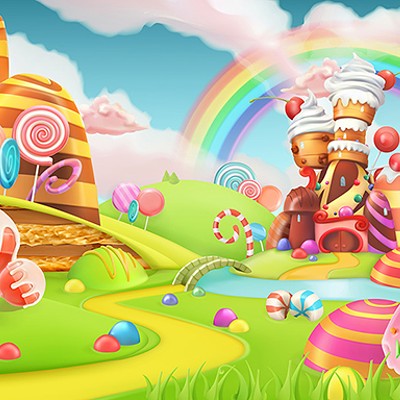Hip Hop-portunity
A new film festival in town gives hip hop its due
Through the Hip-Hop Lens
Street Perspectives
The Scene Not Heard
If you've been to a movie theater anytime in the past week then you probably think you have a fair idea of what a hip-hop film is. Get Rich or Die Tryin', right?
Yeah, that's hip hop. But that ain't all there is to hip hop, especially when it comes to films.
Not that you'd know it taking a walk through Blockbuster Video. Along the walls of "New Releases" you find movies of every variety -- comedies, romances, dramas, documentaries -- all grouped together. But the hip-hop movies stick out.
Maybe you shouldn't judge a DVD by its cover. But when you come across Jacked Up, featuring four grimacing black faces -- two heads covered in black bandanas -- hovering over an image of a masked black male pointing a gun at the driver's side window of a Cadillac Escalade, you don't have to ask Marilyn vos Savant what this movie probably involves.
A couple feet away is Back in the Day, its cover bearing the left half of actor Ving Rhames' face and the right half of rapper Ja Rule's (a la Face/Off), both suspended over Ja Rule kneeling with his arms outstretched. A gun rests in his open left palm. Then there's Ghetto Dawg 2: Out of the Pits, with a scowling bald black thug clad in jeans and a wifebeater, holding chains attached to two slobbering pitbulls with exaggerated incisors.
Even though Get Rich was recently pulled from the Waterfront Loews cineplex after a shooting on the night it premiered, it's not difficult finding another theater in the area that's carrying it. And while we can easily locate Ghetto Dawg 2, hip-hop movies such as Letter to the President, in which hip-hop rappers and scholars alike sound off about governmental policies that have left poor minority communities in America oppressed or neglected, are hard to find in any video store.
Hip hop was once about public access to the creative cultural expressions of the city, but that element has become increasingly less accessible to the public. Nowhere is that truer than in independent hip-hop documentaries and narrative films.
The do-it-yourself model of grabbing the speakerbox and creating your own mixtape, or grabbing the camcorder and creating your own movie, was what made hip hop the gritty, against-the-grain movement it was. Documentaries in the early '80s such as Wild Style and Style Wars captured the explosive hip-hop scene just as it was finding its arms and legs: graffiti, deejaying, B-Boy breaking and rapping. But as box-office-busting melodramas such as Colors, Boyz N the Hood and Menace II Society widened the eyes and pockets of Hollywood CEOs, that hip-hop culture shit just became child's play.
Gangsta-life "reality," Hollywood told us, was the real story of hip hop, and of black culture for that matter. It's to the point where now even straight-to-DVD documentaries won't see any light unless they highlight rappers twirling .45s while instigating the latest beef about which rappers' cars and dicks are bigger.
On the rare occasion that a hip-hop documentary does win some kind of mainstream exposure, it's bestowed on a European or European-American director who's been validated through MTV, HBO or Rolling Stone. Exhibit A is the documentary Rize, about the krumpin'/clownin' dance scene emerging straight outta Compton, done by former magazine photographer David LaChapelle -- who's straight outta Connecticut.
But to find the documentaries and movies that are for hip hop and by hip hop, you have to find, and then travel, the underground railroad of film festivals and gallery screenings. There you'll find documentaries such as Hip-Hop Colony, which shows how hip hop took shape politically and culturally in Kenya. Or, Freestyle: The Art of Rhyme, which documents the last poets of hip hop, who specialize in the improvisational, purely off-the-top-of-the-head art of lyrical freestylin' -- quickly becoming an endangered species in the same hip-hop nation it helped discover.
The Hip Hop Film Festival in Oakland, Calif., and the H2O Film Festival, in New York City, are two events that have worked the past five years to bring rich, intelligent hip-hop cinema to the masses. This week, Pittsburgh continues the struggle with its own Pittsburgh Hip Hop Film Festival, which will showcase more than a dozen hip-hop documentaries and features that show hip-hop youth as far away as Kenya and Colombia as critical activists working for social and political reform in urban communities.
"Gangsta rap today is about as reflective of reality as, well, a reality show. And yet still it lumbers across the landscape of pop, shouting, 'I'm real,'" writes Ta-Nehisi Coates in The Village Voice article "Keepin' It Unreal: $elling the Myth of Bla¢k Male Violen¢e, Long Past Its Expiration Date."
The article talks about how the warfare that erupted in ghettoes when crack first splashed in the '80s has largely calmed down, offset by RICO statutes that had many gang members locked up, and locked out from society. However, images remain in what Coates calls a "neo-gangsta" nostalgia that's "stuck in history rather than rooted in current reality."
That reality may have escaped many Americans. Or many Americans may have escaped that reality. Commercial films that have passed themselves off as the realtalk of hip hop would suggest that the current hip-hop generation is unconscious of how crack and automatic rifles began flooding the hood; how the erosion of the country's manufacturing base led to massive unemployment (leading to massive urban drug and gun investments and trafficking); and how the advertisement of tobacco, liquor, gold, platinum and diamonds became the standard hip-hop content allowable by major entertainment vendors.
There are "gatekeepers that want to see wack images of people of color being the gunslinger, dope-dealer, pimp, et cetera," says Kevin Fitzgerald, a.k.a. DJ Organic, director of Freestyle and a co-founder of the Center for Hip Hop Education in Oakland, Calif. "For people that don't really live that kinda life, they think it's cool -- almost like some kinda kinky sex or porn. It becomes voyeuristic. To me, that shit is played out."
And many in the hip-hop generation aren't blind or ignorant of the politics that have destroyed their environments, domestically or globally. Independent hip-hop films strive to preserve that urban consciousness. Organizations such as the Center for Hip Hop Education and New York's Hip Hop Association (which is a co-sponsor of the Pittsburgh Hip Hop Film Festival) have kept those films alive. Together, they've been producing film festivals that have been traveling the globe for the past four years.
The film festivals are "opportunities to create critical thinking, create community, and to create media and create the space for filmmakers who had been doing all these dope films about hip hop that are redefining the images associated with hip hop," says Rolando Brown. Brown is director of brand development for the Hip Hop Association, which held its fourth annual H20 Film Festival last week.
"We're providing options," says Brown. "We're not in some tall building shouting down to the people 'Look, you're killing our community!' We're from the community, so we know first-hand that we just need options. We focus on creating those options."
According to Kevin Fitzgerald, there's a hip-hop style to everything, including "brushing your teeth" and making a film. With filmmaking, it's "letting the editing be tight and hard, but with style. Being fresh and telling a good story like Slick Rick would. Hip hop is about change and making something old new again [by] putting your fresh style on it."
Local filmmaker Kevin "Grimsta" Fancher of Wilkinsburg's Full Scale Records says the hip-hop way is about "roots," either in the sense of Alex Haley's great American slave epic or hip-hop's avant-garde live music band of the same name. He's been working on a movie called Hostile Takeover, which is a documentary about Pittsburgh black neighborhoods -- the people, buildings and the places where buildings used to be.
"I'm taking you straight to the source, it don't get no rawer than this," says Fancher. "It ain't nobody showing no guns or nothing and it ain't all about rap. It's just a big black arts festival and showing you that we are something on the map."
"Little was known / of Sierre Leone / and how it connects to the diamonds we own / ... Over here, it's a drug trade / we die from drugs / Over there, they die from what we buy from drugs. / The diamonds, the chains, the bracelets, the charmses / I thought my Jesus piece was so harmless / 'til I seen a picture of a shorty armless."
These are lyrics from rapper Kanye West's song "Diamonds Are Forever," a remix in which West talks about the "conflict diamonds" mined in African caves by children as young as 6 years old. These children often get caught in the crossfire of African gangs fighting to win control of the mines. Their story inspired filmmaker Kareem Edouard to create a documentary called Bling: Consequences and Repercussions, an 11-minute short about rappers' obsession with diamonds, and the stones' origins in war-ravaged Africa.
"I was hanging out in Germany with a rapper called Afrob, and he was telling me about a 6-year-old African boy who was working in the mines who started choking because he couldn't breathe," says Edouard. "He asked the overseer there if he could get some water and the overseer said 'Yes.' But when the little boy turned around the overseer shot him dead in the back of the head. I was like, 'It's time for us to shed some light on that.'"
The documentary is narrated by rapper Chuck D and features interviews with Greg Campbell, author of Blood Diamonds: Tracing the Deadly Path of the World's Most Precious Stone. The movie recently secured the financing needed to be turned into a feature-length film.
Edouard had already been working on his project for three years when "Diamonds Are Forever" was released. The song has been a boon, Edouard says, to his work of getting these issues out to the public. The voice you hear at the beginning of the music video for "Diamonds" is African rapper Chozan, a friend of Edouard's who worked on the Bling project.
Edouard's problem, as with many hip-hop film documentarians, was that he couldn't find any funding.
"When I said I was doing a hip-hop documentary, you'd see investors kinda cringe," says Edouard. "I want to be the black Michael Moore, so that hopefully we can go to the Oscars and the Golden Globes and also bring back when hip hop was informative."
Edourd laments that black, Latino and Asian filmmakers can't get the kind of financing and greenlighting that white filmmakers such as Nick Broomfield (Biggie and Tupac) have secured for making movies about black, Latino and Asian culture.
Fitzgerald encountered the same problems trying to get his Freestyle documentary screened.
"All the clichés were hella true on this film," says Fitzgerald. "No one was trying to see intelligent black men tell their story about a music that they created."
Rap music within hip hop is doing its thing bringing more progressive and intellectual content through rappers like Mos Def, Talib Kweli and dead prez. However, "there's no science like that being spit on the visual side -- no one's doing that with documentaries," says Edouard. "We gotta start telling our own stories and investing in ourselves, going to film schools and learning the camera so a dude from Compton or Louisiana can say, 'I want to tell my story,' and it will be something of quality."
Street Perspectives
The Scene Not Heard
If you've been to a movie theater anytime in the past week then you probably think you have a fair idea of what a hip-hop film is. Get Rich or Die Tryin', right?
Yeah, that's hip hop. But that ain't all there is to hip hop, especially when it comes to films.
Not that you'd know it taking a walk through Blockbuster Video. Along the walls of "New Releases" you find movies of every variety -- comedies, romances, dramas, documentaries -- all grouped together. But the hip-hop movies stick out.
Maybe you shouldn't judge a DVD by its cover. But when you come across Jacked Up, featuring four grimacing black faces -- two heads covered in black bandanas -- hovering over an image of a masked black male pointing a gun at the driver's side window of a Cadillac Escalade, you don't have to ask Marilyn vos Savant what this movie probably involves.
A couple feet away is Back in the Day, its cover bearing the left half of actor Ving Rhames' face and the right half of rapper Ja Rule's (a la Face/Off), both suspended over Ja Rule kneeling with his arms outstretched. A gun rests in his open left palm. Then there's Ghetto Dawg 2: Out of the Pits, with a scowling bald black thug clad in jeans and a wifebeater, holding chains attached to two slobbering pitbulls with exaggerated incisors.
Even though Get Rich was recently pulled from the Waterfront Loews cineplex after a shooting on the night it premiered, it's not difficult finding another theater in the area that's carrying it. And while we can easily locate Ghetto Dawg 2, hip-hop movies such as Letter to the President, in which hip-hop rappers and scholars alike sound off about governmental policies that have left poor minority communities in America oppressed or neglected, are hard to find in any video store.
Hip hop was once about public access to the creative cultural expressions of the city, but that element has become increasingly less accessible to the public. Nowhere is that truer than in independent hip-hop documentaries and narrative films.
The do-it-yourself model of grabbing the speakerbox and creating your own mixtape, or grabbing the camcorder and creating your own movie, was what made hip hop the gritty, against-the-grain movement it was. Documentaries in the early '80s such as Wild Style and Style Wars captured the explosive hip-hop scene just as it was finding its arms and legs: graffiti, deejaying, B-Boy breaking and rapping. But as box-office-busting melodramas such as Colors, Boyz N the Hood and Menace II Society widened the eyes and pockets of Hollywood CEOs, that hip-hop culture shit just became child's play.
Gangsta-life "reality," Hollywood told us, was the real story of hip hop, and of black culture for that matter. It's to the point where now even straight-to-DVD documentaries won't see any light unless they highlight rappers twirling .45s while instigating the latest beef about which rappers' cars and dicks are bigger.
On the rare occasion that a hip-hop documentary does win some kind of mainstream exposure, it's bestowed on a European or European-American director who's been validated through MTV, HBO or Rolling Stone. Exhibit A is the documentary Rize, about the krumpin'/clownin' dance scene emerging straight outta Compton, done by former magazine photographer David LaChapelle -- who's straight outta Connecticut.
But to find the documentaries and movies that are for hip hop and by hip hop, you have to find, and then travel, the underground railroad of film festivals and gallery screenings. There you'll find documentaries such as Hip-Hop Colony, which shows how hip hop took shape politically and culturally in Kenya. Or, Freestyle: The Art of Rhyme, which documents the last poets of hip hop, who specialize in the improvisational, purely off-the-top-of-the-head art of lyrical freestylin' -- quickly becoming an endangered species in the same hip-hop nation it helped discover.
The Hip Hop Film Festival in Oakland, Calif., and the H2O Film Festival, in New York City, are two events that have worked the past five years to bring rich, intelligent hip-hop cinema to the masses. This week, Pittsburgh continues the struggle with its own Pittsburgh Hip Hop Film Festival, which will showcase more than a dozen hip-hop documentaries and features that show hip-hop youth as far away as Kenya and Colombia as critical activists working for social and political reform in urban communities.
"Gangsta rap today is about as reflective of reality as, well, a reality show. And yet still it lumbers across the landscape of pop, shouting, 'I'm real,'" writes Ta-Nehisi Coates in The Village Voice article "Keepin' It Unreal: $elling the Myth of Bla¢k Male Violen¢e, Long Past Its Expiration Date."
The article talks about how the warfare that erupted in ghettoes when crack first splashed in the '80s has largely calmed down, offset by RICO statutes that had many gang members locked up, and locked out from society. However, images remain in what Coates calls a "neo-gangsta" nostalgia that's "stuck in history rather than rooted in current reality."
That reality may have escaped many Americans. Or many Americans may have escaped that reality. Commercial films that have passed themselves off as the realtalk of hip hop would suggest that the current hip-hop generation is unconscious of how crack and automatic rifles began flooding the hood; how the erosion of the country's manufacturing base led to massive unemployment (leading to massive urban drug and gun investments and trafficking); and how the advertisement of tobacco, liquor, gold, platinum and diamonds became the standard hip-hop content allowable by major entertainment vendors.
There are "gatekeepers that want to see wack images of people of color being the gunslinger, dope-dealer, pimp, et cetera," says Kevin Fitzgerald, a.k.a. DJ Organic, director of Freestyle and a co-founder of the Center for Hip Hop Education in Oakland, Calif. "For people that don't really live that kinda life, they think it's cool -- almost like some kinda kinky sex or porn. It becomes voyeuristic. To me, that shit is played out."
And many in the hip-hop generation aren't blind or ignorant of the politics that have destroyed their environments, domestically or globally. Independent hip-hop films strive to preserve that urban consciousness. Organizations such as the Center for Hip Hop Education and New York's Hip Hop Association (which is a co-sponsor of the Pittsburgh Hip Hop Film Festival) have kept those films alive. Together, they've been producing film festivals that have been traveling the globe for the past four years.
The film festivals are "opportunities to create critical thinking, create community, and to create media and create the space for filmmakers who had been doing all these dope films about hip hop that are redefining the images associated with hip hop," says Rolando Brown. Brown is director of brand development for the Hip Hop Association, which held its fourth annual H20 Film Festival last week.
"We're providing options," says Brown. "We're not in some tall building shouting down to the people 'Look, you're killing our community!' We're from the community, so we know first-hand that we just need options. We focus on creating those options."
According to Kevin Fitzgerald, there's a hip-hop style to everything, including "brushing your teeth" and making a film. With filmmaking, it's "letting the editing be tight and hard, but with style. Being fresh and telling a good story like Slick Rick would. Hip hop is about change and making something old new again [by] putting your fresh style on it."
Local filmmaker Kevin "Grimsta" Fancher of Wilkinsburg's Full Scale Records says the hip-hop way is about "roots," either in the sense of Alex Haley's great American slave epic or hip-hop's avant-garde live music band of the same name. He's been working on a movie called Hostile Takeover, which is a documentary about Pittsburgh black neighborhoods -- the people, buildings and the places where buildings used to be.
"I'm taking you straight to the source, it don't get no rawer than this," says Fancher. "It ain't nobody showing no guns or nothing and it ain't all about rap. It's just a big black arts festival and showing you that we are something on the map."
"Little was known / of Sierre Leone / and how it connects to the diamonds we own / ... Over here, it's a drug trade / we die from drugs / Over there, they die from what we buy from drugs. / The diamonds, the chains, the bracelets, the charmses / I thought my Jesus piece was so harmless / 'til I seen a picture of a shorty armless."
These are lyrics from rapper Kanye West's song "Diamonds Are Forever," a remix in which West talks about the "conflict diamonds" mined in African caves by children as young as 6 years old. These children often get caught in the crossfire of African gangs fighting to win control of the mines. Their story inspired filmmaker Kareem Edouard to create a documentary called Bling: Consequences and Repercussions, an 11-minute short about rappers' obsession with diamonds, and the stones' origins in war-ravaged Africa.
"I was hanging out in Germany with a rapper called Afrob, and he was telling me about a 6-year-old African boy who was working in the mines who started choking because he couldn't breathe," says Edouard. "He asked the overseer there if he could get some water and the overseer said 'Yes.' But when the little boy turned around the overseer shot him dead in the back of the head. I was like, 'It's time for us to shed some light on that.'"
The documentary is narrated by rapper Chuck D and features interviews with Greg Campbell, author of Blood Diamonds: Tracing the Deadly Path of the World's Most Precious Stone. The movie recently secured the financing needed to be turned into a feature-length film.
Edouard had already been working on his project for three years when "Diamonds Are Forever" was released. The song has been a boon, Edouard says, to his work of getting these issues out to the public. The voice you hear at the beginning of the music video for "Diamonds" is African rapper Chozan, a friend of Edouard's who worked on the Bling project.
Edouard's problem, as with many hip-hop film documentarians, was that he couldn't find any funding.
"When I said I was doing a hip-hop documentary, you'd see investors kinda cringe," says Edouard. "I want to be the black Michael Moore, so that hopefully we can go to the Oscars and the Golden Globes and also bring back when hip hop was informative."
Edourd laments that black, Latino and Asian filmmakers can't get the kind of financing and greenlighting that white filmmakers such as Nick Broomfield (Biggie and Tupac) have secured for making movies about black, Latino and Asian culture.
Fitzgerald encountered the same problems trying to get his Freestyle documentary screened.
"All the clichés were hella true on this film," says Fitzgerald. "No one was trying to see intelligent black men tell their story about a music that they created."
Rap music within hip hop is doing its thing bringing more progressive and intellectual content through rappers like Mos Def, Talib Kweli and dead prez. However, "there's no science like that being spit on the visual side -- no one's doing that with documentaries," says Edouard. "We gotta start telling our own stories and investing in ourselves, going to film schools and learning the camera so a dude from Compton or Louisiana can say, 'I want to tell my story,' and it will be something of quality."


















